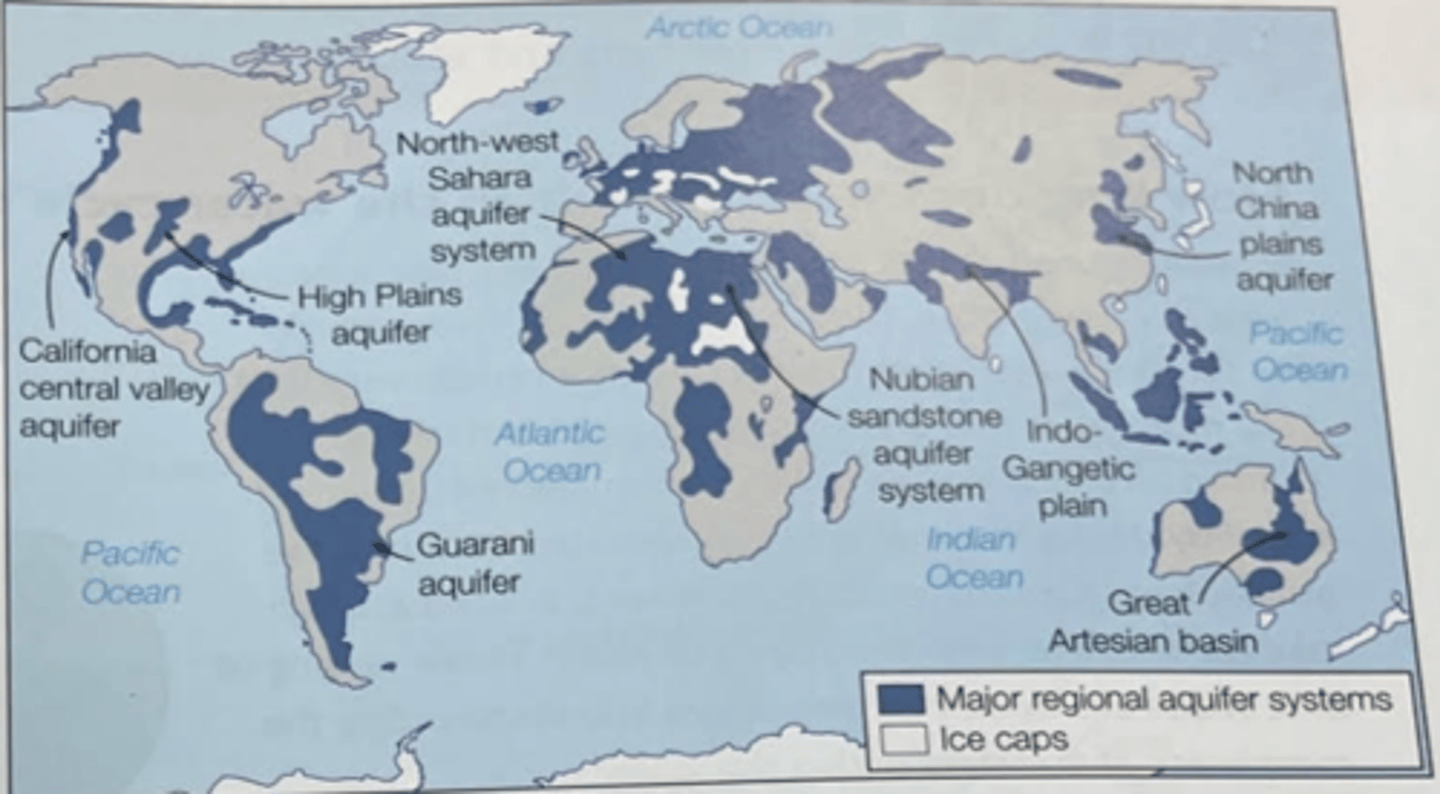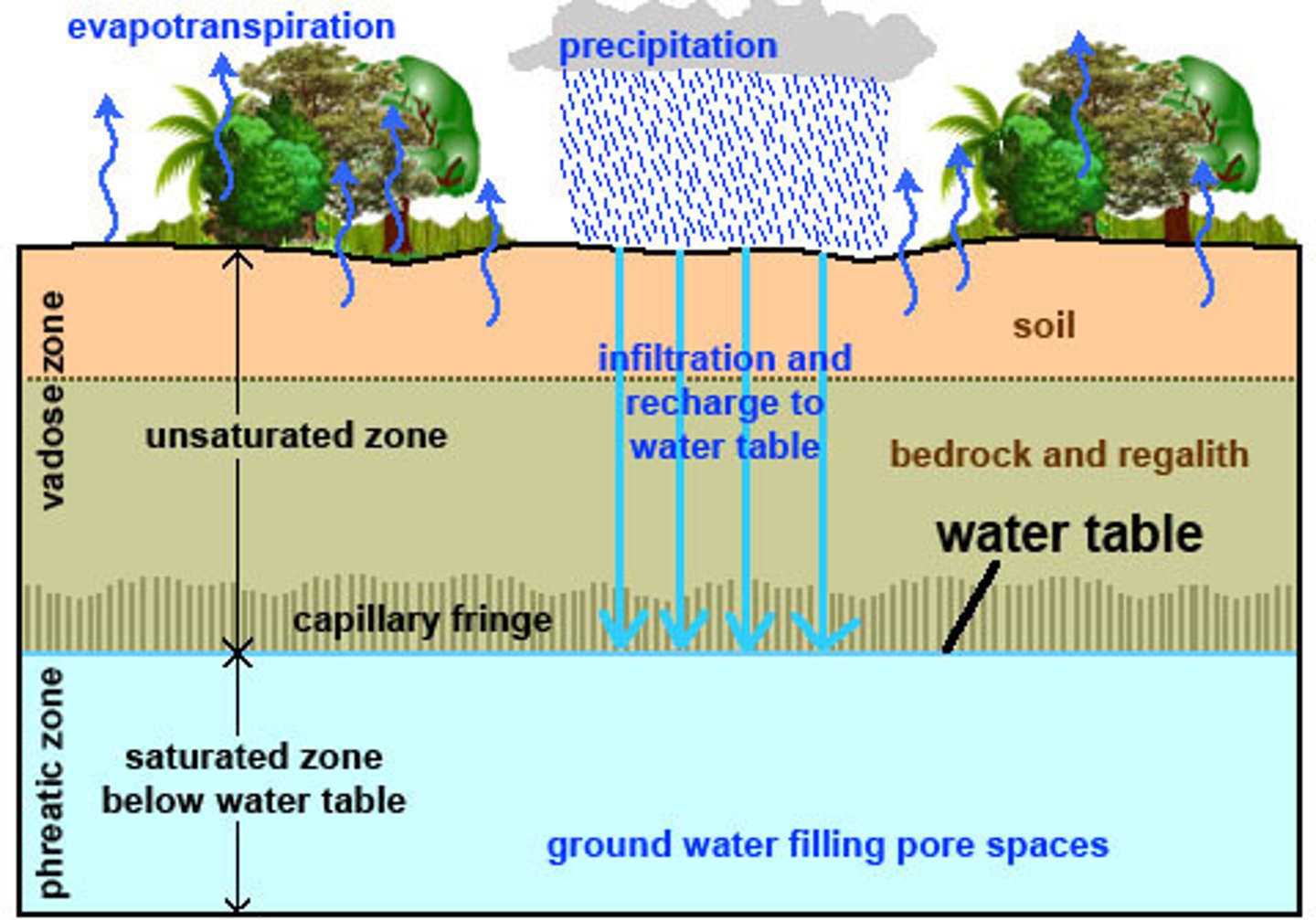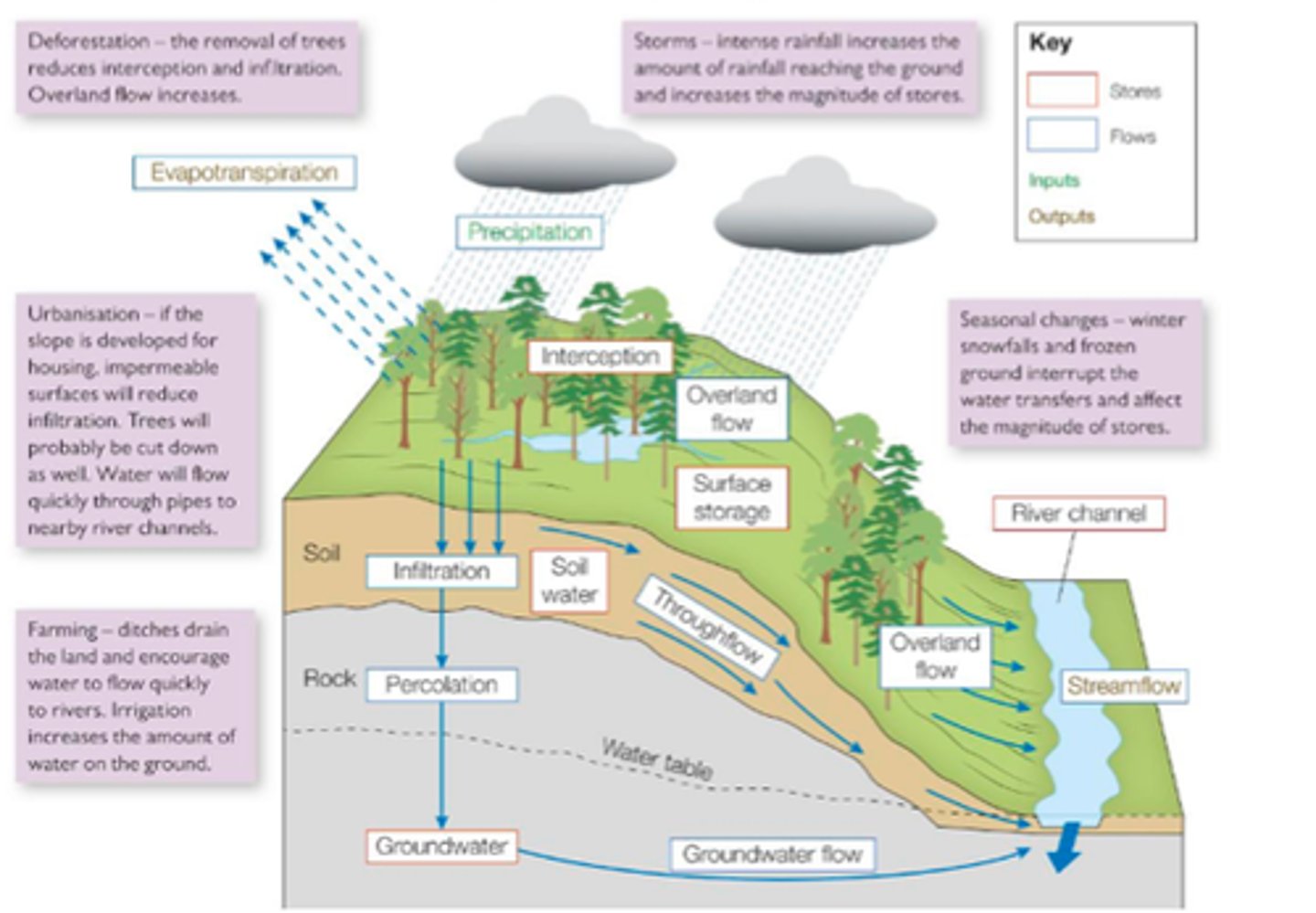(2) The Global Water Cycle
1/50
There's no tags or description
Looks like no tags are added yet.
Name | Mastery | Learn | Test | Matching | Spaced |
|---|
No study sessions yet.
51 Terms
the water cycle
the constant recycling of water between land, ocean and atmosphere
stores of water
most of earth's water is stored as saline (salt) water in oceans
freshwater stores = ice sheets (Antarctica and Greenland)
groundwater store
rivers, lakes, and the atmosphere contain remarkably small amounts of the global water stores
transfers of water
precipitation
... transfers water from the atmosphere to the Earth's surface
evaporation
... moves water back to the atmosphere
infiltration
... the transfer of water into the ground
percolation
... the transfer of water through rocks as groundwater flow
the global hydrological cycle
= a closed system
the global distribution and size of major stores of water
lithosphere, hydrosphere, cryosphere, atmosphere
energy comes from solar energy
sources and sinks = oceans, lakes, rivers, groundwater stores, atmosphere
the makeup of the world's water stores
of the total water on the planet....
97.5% is in oceans
2.5% is freshwater
divisions of freshwater sources
permafrost = 0.8%
groundwater = 30.1%
surface water (river/lakes/wetlands) = 0.4%
glaciers = 68.7%
oceanic water (hydro-spheric)
... the ocean dominates the global water store with approx. 1,350,000,000 km3 to an average depth of 3,700m (96.6% in total)
oceanographers claim that only 5% of the ocean has been explored
oceanic pH
oceanic water contains dissolved salts from rock minerals, pH = alkaline (8.25)
this pH has fallen by 0.1 during the last 250 years due to ocean acidification
Cryospheric water
includes glacial ice, both land based and sea ice, as well as permafrost
glacial ice has many forms such as ice sheets, valley glaciers, and ice shelves
Greenland and Antarctic ice sheets contain 99% of the cyrospheric ice on earth
where do glaciers form?
glaciers form in climate zones where snow (which falls in colder months) does not entirely melt in the summer, the snow accumulates and is compressed under its own weight to form glacial ice
Terrestrial water (hydrospheric and lithospheric)
Surface water = rivers, lakes, and wetlands
- rivers act as a store and transfer water
- Amazon River has a discharge of 209,000 m3/s which is larger than the next 7 largest rivers combined
... rivers make up 0.0002% of global water
Groundwater
Soil water
Biological water
groundwater
defined as water stored in subsurface geology in pore spaces no deeper than 4,000m
(water does no exist in the earth's crust, but has been discovered at depths of 13km)
soil water
= bound to the humus in soil by electrical charge
biological water
= stored in all living biomass
60% of humans is water
Groundwater and Aquifers
most groundwater is contained within 100m of the surface
this can be found in the permanently saturated zone within solid rocks (the phreatic zone)
water table varies seasonally throughout the aeration zone

aquifers
= significant underground reservoirs of water
just over 30% of all freshwater is stored in rocks below the ground surface in aquifers
commonly form in chalk and sandstone rocks as are porous and permeable
water tables - image is chatgpt so might not be accurate
underground surface areas beneath soil or rock which are saturated with water
upper level of saturated rock = phreatic zone
... rises and falls in response to groundwater flow, water abstraction and recharge
aeration zone = immediately below land surface
aquicludes = impermeable barriers

the phreatic zone
permanently saturated zone within solid rocks below the water table
upper levels of of phreatic zone are saturated with water

the role of aquifers + groundwater in the water cycle
1. groundwater recharge of aquifers happen naturally from infiltration, river seepage, and artificial methods
2. underground flow of water directed by hydrostatic pressure and presence of impermeable layers of rock known as aquicludes
3. aquicludes force water to edge of aquifer where it leaks out of rock as a spring
the aeration zone
zone immediately below the land surface where the pores contain both water and air, but are not totally saturated with water
Plant roots can capture the moisture passing through this zone, but it cannot provide water for wells
(also known as the unsaturated zone)
soil water budget
The capacity of soil to store and transfer water
The balance of soil water that involves the amount of precipitation, evapotranspiration, and water storage and loss.
e.g., clay can store water easily but has limited water transfer
e.g., porous sandy soils hold little moisture as water is easily transferred through pores
aquicludes
the impermeable layers that are barriers to groundwater flow
atmospheric water
holds around 0.4% of global total
(12,900 km3 of water vapour)
water exists in all 3 states:
water vapour
water droplets
ice
the role of the atmosphere in the water cycle
water vapour in atmosphere absorbs, scatters and reflects incoming solar radiation
... maintains warmer atmospheric temperature through natural greenhouse effect that is needed for life on earth
evaporation and condensation are key processes
(rate of processes depends on temp. and humidity)
Processes of change in the water cycle
1. Global Atmospheric circulation system (large scale)
2. Climate change (global + regional scale)
3. Hydrological cycle and Drainage Basins (medium + small scale, spatial change)
4. Cryospheric processes (long term, temporal change)
the global atmospheric circulation systems in the water cycle
= the large-scale movement of air by which heat is distributed on the Earth's surface
The wind belts and the jet streams girdling the planet are steered by 3 convection cells:
1. the Hadley cell
2. the ferrel cell
3. the polar cell
The Hadley Cell
Convection Currents that cycle between the equator, 30 degrees North and South.
The Ferrel Cell
30 to 60 degrees.
Air at 30 degrees stable so moves towards the poles towards unstable air, or sub-polar lows
The Polar Cell
A convection current in the atmosphere, formed by air that rises at 60 degrees N and 60 degrees S
sinks at the poles, 90 degrees N and 90 degrees S
global atmospheric circulation + he water cycle
= the driving force behind cloud formation and precipitation
the presence of the 3 interconnected cells show the rising and falling of air in latitudinal zones
ITCZ
Mid-latitude cloud formation
local weather/precipitation
ITCZ - GACM
at the equator, high temperatures result in high rates of evaporation. The warm moist air rises, cools and condenses to form towering banks of cloud and heavy rainfall in Low Pressure Zones
= Inter-Tropical Convergence Zone (ITCZ)
... changes seasonally moving north and south as sun influences the spatial and temporal changes in transfers and stores magnitudes of water
Mid-latitude cloud formation - GACM
cloud formation is mostly driven by convergence of warm air from the tropics and cold air from the Arctic
the boundary of these two air masses (the polar front) results in rising air and cloud/rain formation
strong upper winds from the jet stream drive these unstable weather systems across mid-latitudes
= largely changeable conditions in UK + why we experience storms
Local precipitation - GACM
formation of thunderstorms from intense convective activity
varies in both time and space of water cycle transfer processes
Climate Change in the process of change
last ice age: 1/3 of earth was covered by glaciers and ice sheets
... water was "locked up" in snow and ice
... sea levels were a lot lower
warmer periods, sea levels started to rise as ice melted
... change in cryospheric and hydrospheric stores
global warming = rising temperatures
... sea levels rising as glacial ice melts (eustatic)
Drainage Basin and hydrological cycle processes of change
Medium/Small scale
spatial change
dependent on the type and rate of processes present
also dependent on the stores
e.g., soil water budget, the geology and permeability of rocks and soils
may also change temporally
e.g., seasonal changes
(melting and freezing of sea ice, permafrost soils)
relief of land
e.g., hillslope scale
... by isolating a section of the global hydrological cycle you create an open system within a larger closed system
the hillslope water cycle - process of change at the local scale
dependent on inputs, outputs, flows, and stores
amount of water stores can hold is often dependent on many factors operating over relatively short timescales or the magnitude of processes
Deforestation - removal of trees reduces interception and infiltration, overland flow increases
Storms - intense rainfall increases the amount of rainfall reaching the ground and increases the magnitude of stores
Seasonal Changes - winter snowfalls and frozen ground interrupt the water transfers and affect the magnitude of stores
Urbanisation - if the slope is developed (e.g., housing) impermeable surfaces will reduce infiltration. Trees will probably be cut down as well. Water will flow quickly through pipes to nearby river channels
Farming - ditches drain the land and encourages water to flow quickly to rivers. irrigation increases the amount of water on the ground

cryospheric processes in change
2nd largest store of water = in ice
(99% of ice is in Antarctic and Greenland ice sheets)
snow falling on glaciers and ice sheets become compressed and enter long term storage, forming layers of glacial ice
shorter timescale: snow accumulates during winter adds to the mass of a glacier or ice sheet. In summer, melting occurs or ice calves
glacial equilibrium line = marks the altitude where annual accumulation and melting are equal
... recent decades, climate has warmed so equilibrium line has moved to higher altitudes
--> most glaciers in the world are now shrinking or retreating

cryospheric processes
i.e., glaciation
the processes that affect the total mass of ice at any scale from local patches of frozen ground to global ice amounts
... include formation and loss of glacial ice
how does glacial ice form
about 70% of the worlds freshwater is stored and transported as glacial ice
snow falls in winter, doesn't fully melt in summer and accumulates, compresses to form glacial ice. Over thousands of years glacial ice layers build up to form glaciers
glacial ice is blue as no air is trapped inside of it
(snow is white due to being composed of 90% trapped air)
snowflake - granular snow - firn - glacial ice
how alpine glaciers work as a system
- Overall, inputs throughout the year are less than the outputs, causes ablation
- Ablation zone means that the ice is melting away
- Outputs of evaporation and sublimation (solid to gas) dominate
- High outputs of meltwater in summer
- Big chunks of ice may break off due to sublimation, creating ice bergs or ice shelves
(glacier = temporary cryospheric store)
ablation zone
area or zone where previous snow from the previous winter melts, exposing bare ice
glacier mass balance
the difference between the amount of snow and ice accumulation and the amount of ablation occurring in a glacier over one year
winter = positive mass balance
... the accumulation of ice is greater than the ablation of ice through outputs
summer = negative mass balance
... the accumulation of ice is less than the ablation of ice through outputs
impact of climate change on glacier mass balance
Climate change will cause an earlier shift to negative mass balance and possibly a permanent decrease in the duration of a positive mass balance, until there is no positive balance left
melting of ice on sea levels - processes of change
the total melting of all the polar ice sheets could reuslt in a 60m rise in sea level
... adds water to ocean store that it cannot manage
positive feedback of sea level rise causing more ice calved, leading to increase in melting ice sheets which increases sea level rise
ice calves
where ice breaks away
example of cryopshere + glacier mass balance
Storbreen Glacier, Norway
mass balance is now largely negative
(changes from 1990 - 2014)
Types of rainfall
relief, frontal, convectional
relief rainfall
stage 1:
warm wet air is forced to rise over high land
stage 2:
as the air rises it cools and condenses
... clouds form an precipitation occurs
stage 3:
... the drier air descends and warms
stage 4:
any moisture in the air evaporates (e.g., clouds)
convectional rainfall
stage 1: the sun heats the ground and warm air rises
stage 2:
as the air rises it cools and condenses
... clouds form an precipitation occurs
stage 3:
large cumulonimbus clouds are formed
stage 4:
heavy rain storms occur
... these usually include thunder and lightening
frontal rain
stage 1:
an area of warm air meets an area of cold air
stage 2:
the warm air is forced over the cold air
stage 3:
where they converge, the warm air cools and water vapour condenses
stage 4:
clouds form and precipitation occurs